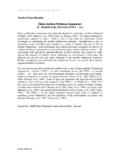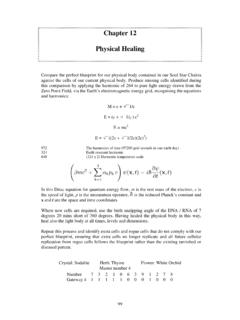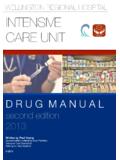Transcription of 270 Anaesthesia and Liver disease Part 1 - FRCA
1 Sign up to receive ATOTW weekly - email ATOTW 270 anaesthesia and liver disease part 1 03/09/2012 Page 1 of 7 Anaesthesia AND Liver disease part 1 Anaesthesia TUTORIAL OF THE WEEK 270 3RD SEPTEMBER 2012 Dr Natalie Drury St James s University Hospital Leeds, UK Correspondence to QUESTIONS Before continuing, try to answer the following questions. The answers can be found at the end of the article, together with an explanation. 1. In which hepatic zone do hepatocytes have the largest concentration of CYP2E1 enzymes, and as such are most sensitive to NAPQI production in paracetamol overdose?
2 A. Zone 1 b. Zone 2 c. Zone 3 d. All zones equally vulnerable 2. How is encephalopathy severity classified? INTRODUCTION The Liver is a large, complex organ with a multitude of different functions. Patients with Liver failure present a significant challenge to the anaesthetist. A good understanding of normal Liver physiology, causes of Liver dysfunction and its multi-system impact on patient function is very important in managing these patients. This is the first of a two- part tutorial looking at Liver anatomy, function, acute and chronic failure and the physiological changes associated with Liver disease .
3 The second tutorial will then look at the considerations and practicalities of anaesthetising this patient group, the indications for Liver transplantation and will briefly consider Anaesthesia in the post Liver transplant patient. ANATOMY The Liver is the second largest organ in the human body after the skin. It lies in the right upper abdominal quadrant, weighs around to kg and receives 25% of cardiac output with a total blood flow of around l/min. The Liver has a unique dual blood supply provided by the hepatic artery and the hepatic portal vein.
4 The hepatic portal vein accounts for almost 75% of the Liver s blood supply, providing around half its oxygen requirements. Venous drainage is via the left, right and middle hepatic veins to the inferior vena cava (IVC). The Liver is divided into the right and left lobes by the falciform ligament, with the right lobe being the larger. This division is not of any surgical use however, and the division by Cantile s line, running from the gallbladder fossa to the IVC fossa, provides a more useful division between left and right based on the hepatic artery and portal vein branches.
5 Each Liver lobe is further subdivided by the right and left hepatic veins into four sectors. These are the medial and lateral sectors on the left and posterior and anterior sectors on the right. The sectors are then further divided into segments, each with its own blood supply and biliary drainage. These segments are often described by the Couinaud classification, which numbers these functionally independent segments from one to eight. Sign up to receive ATOTW weekly - email ATOTW 270 anaesthesia and liver disease part 1 03/09/2012 Page 2 of 7 Anatomically, the functional unit of the Liver is the lobule.
6 Blood enters the lobules through branches of the portal vein and hepatic artery, flowing through small channels called sinusoids which are lined with hepatocytes. Drainage from the lobule is through the central hepatic venule. Each hexagonal lobule has a central portal tract containing branches of the hepatic artery, portal vein and bile ducts. From a metabolic perspective, the functional unit is the hepatic acinus. Each acinus consists of a mass of hepatocytes aligned around the hepatic arterioles and portal venules, centered on the line connecting two portal triads and extending outwards to the two adjacent central veins.
7 Each acinus is divided into zones that correspond to their distance from the arterial blood supply. Those hepatocytes closest to the arterioles are the best oxygenated, this is zone 1 or the periportal zone. The further the distance from the arterial blood supply the poorer the oxygen supply, zone 2 being less well oxygenated than zone 1. Zone 3 or the centrilobular zone has the poorest oxygenation of all, making it the most sensitive to ischaemic injury. This arrangement of zones means hepatocytes in zone 1 are specialised for oxidative Liver functions such as gluconeogenesis.
8 These hepatocytes are also the first to encounter blood-borne toxins and incur injury from the deposition of hemosiderin in haemochromatosis. Hepatocytes in zone 3 carry out glycolysis, lipogenesis and cytochrome P-450 based drug detoxification. Zone 3 cells are most sensitive to N-acetyl-p-benzoquinonimine (NAPQI) production in paracetamol overdose, having the highest concentration of CYP2E1 enzymes. The Liver has substantial functional reserve because of its significant blood supply, therefore clinical manifestations of Liver damage only occur after considerable injury.
9 Hepatic blood flow is increased by the following factors: supine position, ingestion of food, hypercapnia, acute hepatitis and drugs (such as barbiturates and P450 enzyme inducers). Conversely, hepatic blood flow is decreased by upright positioning, IPPV/PEEP, hypocapnia, hypoxia, cirrhosis and certain drugs (such as propofol, volatile anaesthetic agents and -blockers). FUNCTION The Liver performs a multitude of different functions including: Amino acid synthesis, gluconeogenesis, glycogenolysis, glycogenesis Protein metabolism, lipid metabolism, lipogenesis and lipoprotein synthesis Coagulation factor production (fibrinogen, prothrombin, V, VII, IX, X and XI, protein C and protein S) Bile production and excretion, IGF-1 and thrombopoietin production.
10 Albumin production, hormone synthesis Storage of glycogen, vitamin A, D, B12, iron and copper. Drug and toxin metabolism: PHASE I: oxidation/reduction/hydrolysis, alteration of intrinsic molecular structure, P450 based drug detoxification PHASE II : conjugation with second substance to increase polarity, gluconeogensis, beta-oxidation of fatty acids and cholesterol synthesis TESTS OF Liver FUNCTION Despite the numerous synthetic, excretory and detoxification functions carried out by the Liver , only a few can be measured by means of blood tests.















